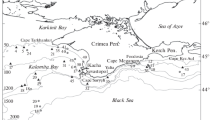Abstract
The change in bioluminescence field intensity at night in the western part of the Black Sea has been investigated. A difference in the dynamics of the bioluminescence field intensity in the upper (0–35 m) and deep (>35 m) layers has been shown. It is elucidated with multivariate statistical analysis that the bioluminescent species are in the space of influence of several factors, including both biotic and abiotic. Biotic factors are shown to exhibit the greatest effect on the periodicity of the bioluminescence field intensity increase and decrease at night. Abiotic factors are less significant in the bioluminescence circadian rhythms.
Similar content being viewed by others
References
Aivazyan, S.A., Bukhshtaber, V.M., Enyukov, I.S., et al., Prikladnaya statistika: Klassifikatsiya i snizhenie razmernosti (Applied Statistics: Classification and Reduction of Dimension), Moscow: Finansy i statistika, 1989.
Bityukov, E.P., Characteristics of the circadian rhythm of bioluminescence of Noctiluca miliaris in the Black Sea, Zool. Zh., 1968, vol. 47, no. 1, pp. 36–41.
Bityukov, E.P., Vasilenko, V.I., Serikova, I.M., et al., Results and prospects for the study of bioluminescence in the Black Sea, Ekol. Morya, 1996, no. 45, pp. 19–25.
Burmistrova, N.V., Zhuk, V.F., and Mel’nikova, E.B., Relationship between the bioluminescence field intensity and the hydrological characteristics of the environment on the Kruglaya Bay beam, Visn. ZNU. Biol. Nauki Zaporizhzhya, 2010, no. 2, pp. 84–92.
Burmistrova, N.V., Tokarev, Yu.N., Vasilenko, V.I., et al., Sovremennye problemy morskoi inzhenernoi ekologii (izyskaniya, OVOS, sotsial’no-ekonomicheskie aspekty): Mater. Mezhdunar. nauch. Konf. (Modern Problems Marine Engineering Ecology (Surveys, EIA, and Socioeconomic Aspects): Proc. Intern. Sci. Conf.), Rostov-on-Don, 2008, pp. 59–62.
Greze, V.N., Daily phytoplankton measurements in the Black Sea, in Osnovy biologicheskoi produktivnosti Chernogo morya (Fundamentals of the Biological Productivity of the Black Sea), Kiev: Nauk. Dumka, 1979, pp. 79–85.
Delalo, E.P., On the daily rhythm in feeding of Pseudocalanus elongates (Boeck), Tr. Sevastopol. Biol. St. AN USSR, 1961, vol. 15, pp. 94–100.
Evstigneev, P.V. and Bityukov, E.P., Biolyuminestsentsiya morskikh kopepod (Bioluminescence of Marine Copepods), Kiev: Nauk. Dumka, 1990.
Lanskaya, L.A., The diurnal variation of the division of some species of planktonic algae of the Black Sea in the cultures, in Biologiya i raspredelenie planktona yuzhnykh morei (Biology and Distribution of Plankton of the Southern Seas), Moscow: Nauka, 1967, pp. 16–21.
Mandel’, I.D., Klasternyi analiz (Cluster Analysis), Moscow: Finansy i statistika, 1988.
Mashtakova, G.P., Daily Dynamics of Phytoplankton in the Black Sea, Tr. Azovo-Chernomor. Inst. Ryb. Khoz. Okeanogr., 1968, no. 27, pp. 60–72.
Pavlova, E.V. and Sorokin, Yu.I., Bacterial food of the planktonic crustacean Penilia avirostris Dana from the Black Sea, Biol. Morya, 1970, no. 19, pp. 182–199.
Piontkovskii, S.A. and Petipa, T.S., Electivity in the diet of Acartia clause (Giesbr.), Biol. Morya, 1975, no. 33, pp. 3–10.
Ruzova, A.I. and Krupatkina, D.K., The use of principal component analysis in the ecology of marine phytoplankton (review), Ekol. Morya, 1983, no. 13, pp. 65–71.
Serikova, I.M., Tokarev, Yu.N., Zagorodnyaya, Yu.A., et al., Bioluminescence as an index of spatial dimensions of plankton fields, in Environmental Problems of the Black Sea: Int. Sci.-Pract. Conf.), Odessa, 2009, pp. 207–209.
Tokarev, Yu.N., Bityukov, E.P., Vasilenko, V.I., et al., Bioluminescence field—a characteristic component of the plankton community structure of the Black Sea, Ekol. Morya, 2000, no. 53, pp. 20–25.
Harman, G., Sovremennyi faktornyi analiz (Modern Factor Analysis), Moscow: Statistika, 1972.
Cattell, R.B., The Scree test for the number of factors, Multivariate Behav. Res., 1966, no. 1(2), pp. 245–276.
Author information
Authors and Affiliations
Corresponding author
Additional information
Original Russian Text © E.B. Melnikova, N.V. Lyamina, 2014, published in Biologiya Vnutrennikh Vod, 2014, No. 4, pp. 5–11.
Rights and permissions
About this article
Cite this article
Melnikova, E.B., Lyamina, N.V. Factors affecting change in bioluminescence field intensity at night. Inland Water Biol 7, 307–312 (2014). https://doi.org/10.1134/S1995082914040105
Received:
Published:
Issue Date:
DOI: https://doi.org/10.1134/S1995082914040105




